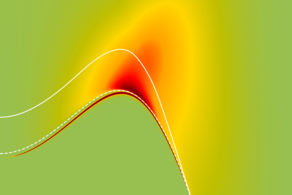PhD Defense of Philipp Schering
- Events
- Uhrig
- PhD defense
Nonequilibrium spin phenomena in quantum dots induced by periodic optical excitation
The coherent control of a charge carrier spin that is localized in a semiconductor quantum dot and the generation of long-lived states for information storage are of particular interest for quantum information processing. This spin interacts predominantly with the surrounding nuclear spins in the quantum dot, which can be described by the central spin model. The periodic application of circularly polarized laser pulses induces nonequilibrium spin dynamics in the quantum dot, giving rise to various phenomena that can be observed in experiments. In this thesis, models and semiclassical approaches are developed to simulate the driven spin dynamics in this system under experimental conditions. For the case where a transverse magnetic field is applied, it is found that the part of the spin mode locking effect stemming from nuclei-induced frequency focusing depends nonmonotonically on the magnetic field strength, with strong similarities to experimental observations. The complex behavior is related to various nuclear magnetic resonances with respect to the repetition rate of the laser pulses, which can be exploited for novel kind of nuclear magnetic resonance spectroscopy of the emerging nonequilibrium steady states. For the case where a longitudinal magnetic field is applied, the influence of the pump pulse power on the spin inertia and on the polarization recovery effect is analyzed. With the help of the developed model, the related experiments can be understood and described quantitatively. In this context, a novel effect termed resonant spin amplification in Faraday geometry is predicted, which enables the direct measurement of the longitudinal g factor of the resident charge carriers. Model calculations are used to find the optimal conditions for its detection and ways to improve its visibility are pointed out. The comparison with recent experiments that demonstrate the realization of the effect shows a remarkable agreement.








